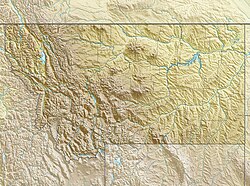| Shepard Glacier | |
|---|---|
 Shepard Glacier as photographed in 2005 | |
| Type | Glacieret |
| Location | Glacier National Park, Glacier County, Montana, U.S. |
| Coordinates | 48°51′56″N113°51′32″W / 48.86556°N 113.85889°W [1] |
| Area | Less than 25 acres (0.10 km2) in 2009 |
| Terminus | Talus |
| Status | Retreating |
Shepard Glacier is a glacier remnant (glacieret) In Glacier National Park in the U.S. state of Montana. The glacieret is immediately southeast of Cathedral Peak. [2] Shepard Glacier was one of a number of glaciers that have been documented by the United States Geological Service (USGS) to have retreated significantly in Glacier National Park. [3] Shepard Glacier was measured in 2009 to have decreased to less than 25 acres (0.10 km2), considered to be a minimal size to qualify as being considered an active glacier. [4] Between 1966 and 2005, Shepard Glacier lost 56 percent of its surface area. [5]
Comparing the 2005 image at right to the one below taken in 1913, it is apparent that Shepard glacier has retreated significantly between these dates.

